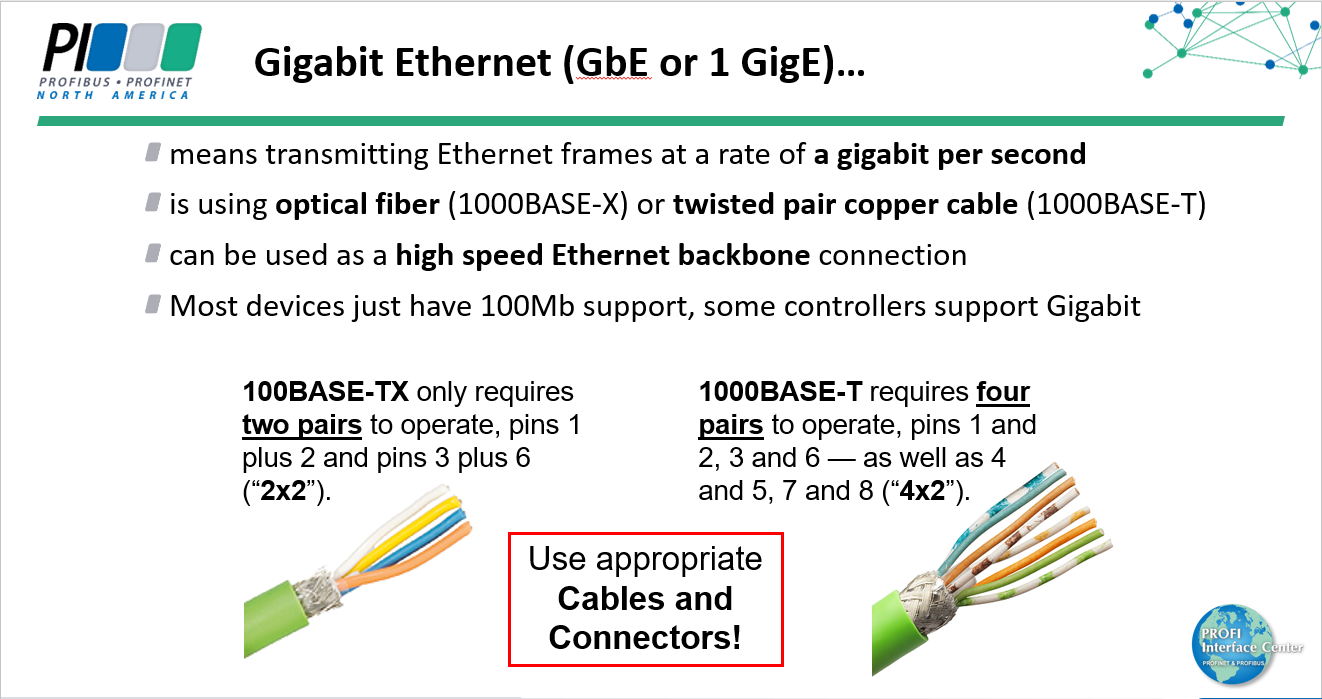Have you considered Gigabit Ethernet for your PROFINET installation?
PROFINET and Gigabit Ethernet (or even faster) are complementary technologies that work well together. However, there are some important considerations you should explore before planning your installation. For example, do you need Gigabit Ethernet for your entire network installation? What about the wiring? Maybe you already have Gigabit Ethernet, but do your IO devices support it? Is Gigabit Ethernet needed for motion control with PROFINET IRT? What are the costs involved? In today’s topic, we will cover the key considerations when implementing Gigabit Ethernet and share our takeaways.
“Just because you can does not always mean you should.”
This saying applies to Gigabit Ethernet and PROFINET. Why? Well, it is because most PROFINET IO devices (or other Industrial protocol devices for that matter) do not support Gigabit performance onboard the port(s). This is also true for devices with the high deterministic capability of Isochronous Real Time (IRT). And the reason for that is simple: most IO devices are sending smaller amounts of information across the network and do not need the extra bandwidth, wires, or hardware.
Product vendors use Fast Ethernet to reduce costs and simplify communications. Plugging in a Gigabit cable in those devices will still work; however, the network speed will auto-negotiate to 100 Mbit/s full-duplex. Therefore, it may not make sense to have the entire network be wired for Gigabit Ethernet. You can, if you want to future proof the system, but it may increase your installation costs, and perhaps even change your network design.
Wiring and Installation Differences – Fast Ethernet vs. Gigabit Ethernet

There are differences between Fast Ethernet (100 Mbit/s) vs. Gigabit Ethernet (1000 Mbit/s) (see above picture). Fast Ethernet only uses 2 pairs or 4 wires while Gigabit Ethernet uses 4 pairs or 8 wires. The connectors, cables, and wiring color will likely be different.
Those extra wires may be an electrician’s dream but can be an engineer’s nightmare. There are a few main reasons for this. First, the more wires, the thinner they need to be. This can make the cables and connectors trickier to install and design in the system to avoid signal loss/attenuation. Also, costs increase for wiring, connectors, and network components. And the overall project costs will be higher. When using Gigabit Ethernet and PROFINET, remember to follow correct wiring practices and PROFINET installation guidelines. Analyze where you need it, what devices support it, and the cable and component costs. Finally, design and install the network correctly.
Main Benefits and Application Examples
What devices support Gigabit Ethernet, you may ask? As needed, some network components such as switches (PROFINET enabled or not) and IO controllers (PLCs, PACs, PCs) support it.
There are two main areas in an automation network where Gigabit performance makes sense:
- At the controller level
- For the network backbone
First, to discuss the latter, at the Industrial network backbone, there is typically going to be a lot of traffic. This traffic includes the Industrial protocols, and also, often includes IT protocols (TCP/IP based) or other protocols which can eat up a lot more of the bandwidth. On a Fast Ethernet system with 100 Mbit/s, this bandwidth can be starved rather quickly. Placing Gigabit Ethernet on your network backbone can help reduce the network load at critical points and keep this traffic flowing. There are tools available to estimate network loads before installation and even afterward. The load should never be higher than 50% capacity. If the network load becomes too high, issues such as device timeouts could occur and cause all sorts of trouble and keep your maintenance department busy.
The second place where Gigabit Ethernet makes sense would be at the controller level (PLC, PAC, PC) since most traffic to all of your devices is going in and out at the controller, and it is handling all of the IO. Gigabit Ethernet can help prevent bottlenecks at the controller and make communication as fast as possible. Check with your product vendors if you are looking for controllers or switches with Gigabit capabilities. Also, ensure that your ports are set to “Auto” between the components. Then, the fastest or correct speed will be negotiated.
PROFINET is Future Proof with TSN and Gigabit
With the latest release of the V2.4 specification, PROFINET is ready for the future with the addition of the new and upcoming Ethernet / TSN standard. TSN makes Ethernet truly deterministic, and it has provisions for Gigabit (1000 Mbit/s) Ethernet which allow for network cycle times down to 31.25 μs with max end to end latency of 6.25 μs – 200 μs. If you want to learn more about TSN, we have a recent TSN webinar posted here.
Conclusion
In conclusion, PROFINET with Gigabit Ethernet is straightforward. Still, you must take the proper considerations when it comes to design and installation, account for additional costs, and employ products that support Gigabit Ethernet. We hope this information will be helpful with your next PROFINET project if questions on Gigabit performance come up.
If you are interested in learning more about PROFINET, we offer training throughout the year at our Certified or customized training classes and would be happy to have you attend.
 Gain a deeper understanding of PROFINET by attending a PROFINET Certified Network Engineer Course.
Gain a deeper understanding of PROFINET by attending a PROFINET Certified Network Engineer Course.
These certification classes are intense, hands-on courses. You will learn how the underlying technology works from the application to the frame level. After passing both a practical and written exam, you become certified.
For more information, contact us or visit our website.
